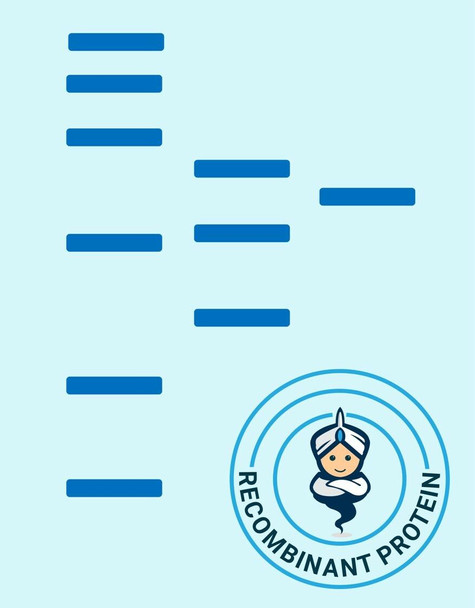Human NREP Recombinant Protein (RPPB4123)
- SKU:
- RPPB4123
- Product Type:
- Recombinant Protein
- Species:
- Human
- Uniprot:
- Q16612
Frequently bought together:
Description
| Product Name: | Human NREP Recombinant Protein |
| Product Code: | RPPB4123 |
| Size: | 10µg |
| Species: | Human |
| Target: | NREP |
| Synonyms: | Neuronal regeneration-related protein, Neuronal protein 3.1, Protein p311, NREP, C5orf13, P311, PTZ17, Chromosome 5 Open Reading Frame 13, Neuronal Regeneration Related Protein Homolog (Rat), D4S114, PRO1873, SEZ17, Neuronal Regeneration Related Protein Homolog, Neuronal Regeneration-Related Protein. |
| Source: | Escherichia Coli |
| Physical Appearance: | Sterile Filtered colorless solution. |
| Formulation: | The NREP solution (0.5mg/ml) contains 20mM Tris-HCl buffer (pH8.0), 10% glycerol and 0.1M NaCl. |
| Stability: | Store at 4°C if entire vial will be used within 2-4 weeks. Store, frozen at -20°C for longer periods of time. For long term storage it is recommended to add a carrier protein (0.1% HSA or BSA).Avoid multiple freeze-thaw cycles. |
| Purity: | Greater than 85.0% as determined by SDS-PAGE. |
| Amino Acid Sequence: | MGSSHHHHHH SSGLVPRGSH MGSMVYYPEL FVWVSQEPFP NKDMEGRLPK GRLPVPKEVN RKKNDETNAA SLTPLGSSEL RSPRISYLHF F |
Neuronal Regeneration Related Protein (NREP) has roles in neural function. NREP promotes axonal regeneration. In addition, NREP has functions in cellular differentiation. NREP protein induces differentiation of fibroblast into myofibroblast and increases retinoic-acid regulation of lipid-droplet biogenesis. NREP down-regulates the expression of TGFB1 and TGFB2 but not of TGFB3. NREP has a role in the regulation of alveolar generation.
NREP Human Recombinant produced in E.coli is a single, non-glycosylated polypeptide chain containing 91 amino acids (1-68) and having a molecular mass of 10.3kDa.NREP is fused to a 23 amino acid His-tag at N-terminus & purified by proprietary chromatographic techniques.
| UniProt Protein Function: | May have roles in neural function. Ectopic expression augments motility of gliomas. Promotes also axonal regeneration (). May also have functions in cellular differentiation (). Induces differentiation of fibroblast into myofibroblast and myofibroblast ameboid migration. Increases retinoic-acid regulation of lipid-droplet biogenesis (). Down-regulates the expression of TGFB1 and TGFB2 but not of TGFB3 (). May play a role in the regulation of alveolar generation. |
| UniProt Protein Details: | |
| NCBI Summary: | |
| UniProt Code: | Q16612 |
| NCBI GenInfo Identifier: | 4758866 |
| NCBI Gene ID: | 9315 |
| NCBI Accession: | NP_004763 |
| UniProt Secondary Accession: | Q16612,B2RDN8, B7Z5D2, D3DSZ8 |
| UniProt Related Accession: | Q16612 |
| Molecular Weight: | 10.3kDa (91aa) confirmed by MALDI-TOF |
| NCBI Full Name: | neuronal regeneration-related protein isoform a |
| NCBI Synonym Full Names: | neuronal regeneration related protein |
| NCBI Official Symbol: | NREP�� |
| NCBI Official Synonym Symbols: | P311; PTZ17; SEZ17; D4S114; C5orf13; PRO1873�� |
| NCBI Protein Information: | neuronal regeneration-related protein |
| UniProt Protein Name: | Neuronal regeneration-related protein |
| UniProt Synonym Protein Names: | Neuronal protein 3.1; Protein p311 |
| Protein Family: | Neuronal regeneration-related protein |
| UniProt Gene Name: | NREP�� |
| UniProt Entry Name: |










